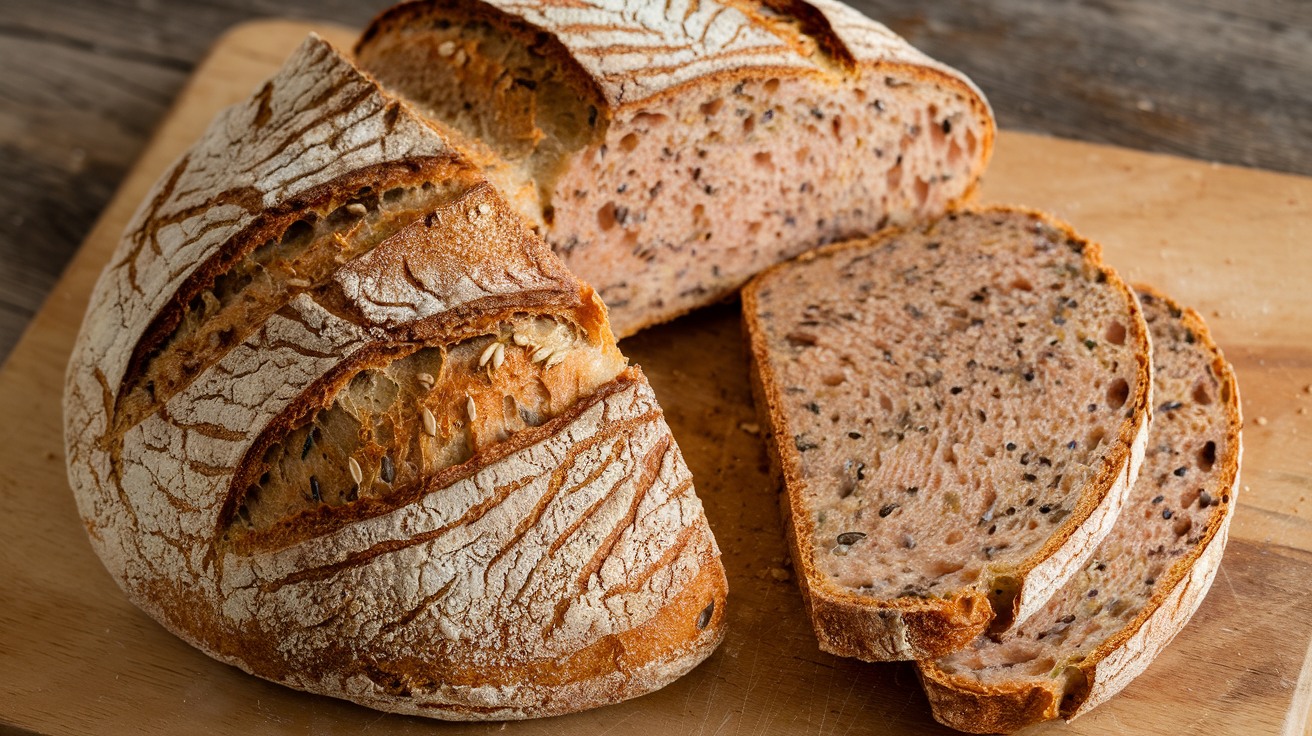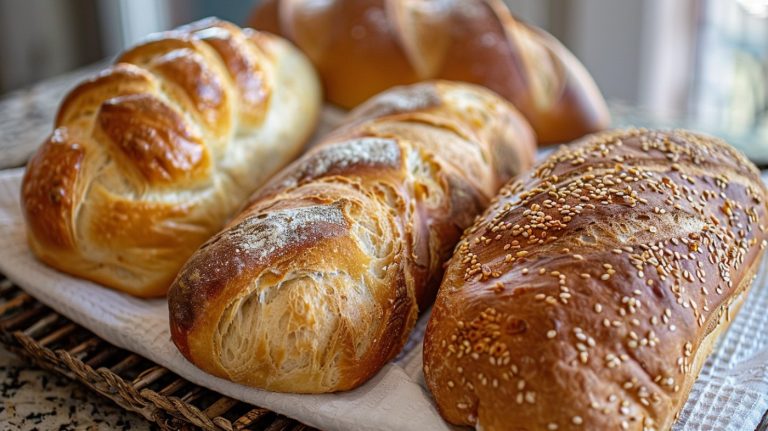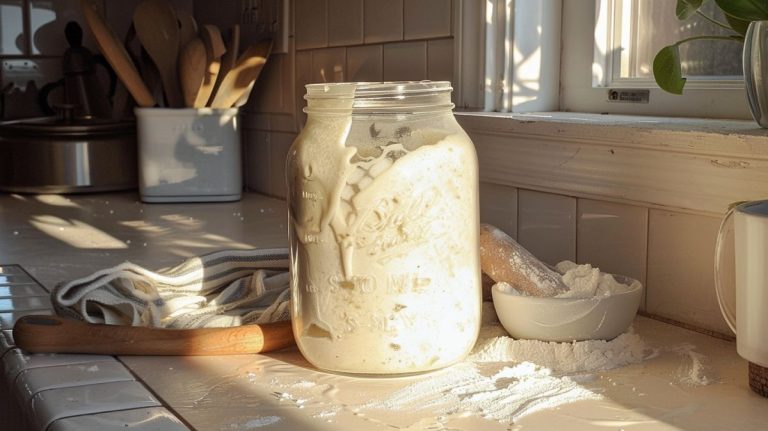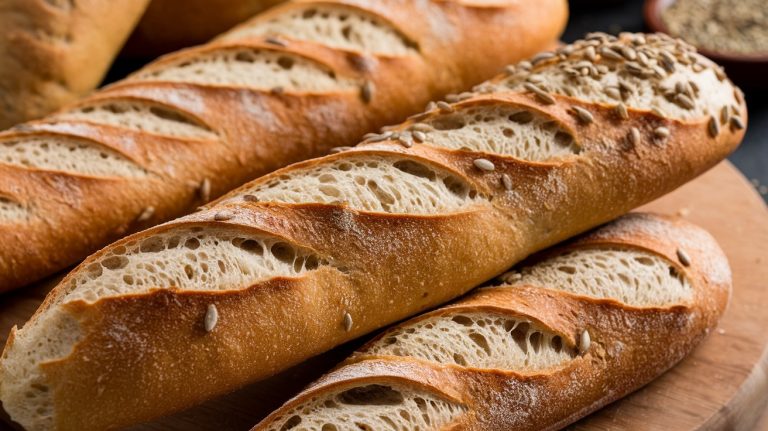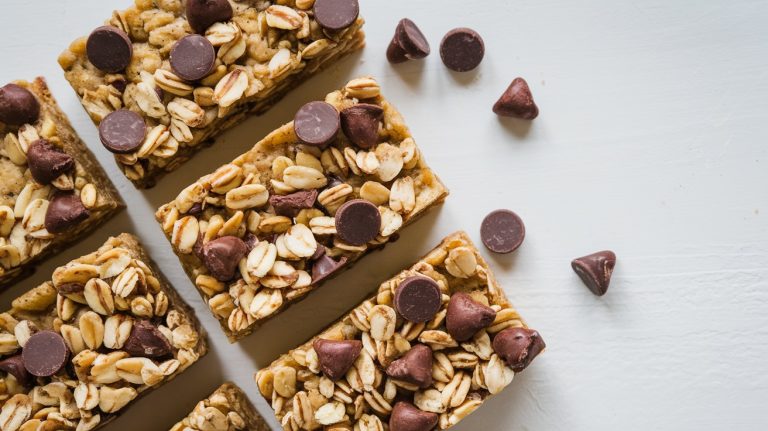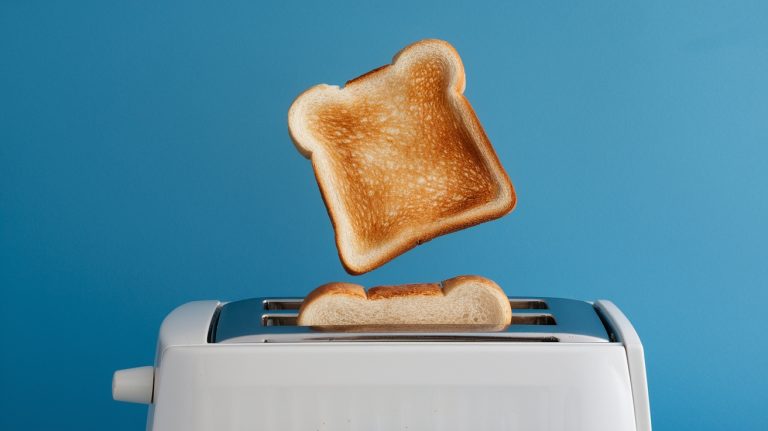Multigrain Sourdough Bread Recipe: Flavor Meets Nutrition
You’ll love baking multigrain sourdough bread, a delicious fusion of flavor and nutrition. Start with a mix of whole grain flours like whole wheat and rye, combined with a robust sourdough starter for that distinctive tang.
Add soaked seeds like flax or sunflower for extra crunch. Prepare your dough with fermentations and gentle stretching to develop gluten. Once shaped, let it rise before scoring and baking in a preheated Dutch oven for a perfect crust.
The result is a hearty loaf that’s great for sandwiches or toast. Stay tuned for more tips and tricks.
Key Takeaways
- Use a blend of whole grains like whole wheat and rye for depth, with a hydration level of around 80.44% for optimal dough consistency.
- Incorporate a sourdough starter for fermentation, enhancing flavor and digestibility while allowing for a longer fermentation process.
- Include optional seeds such as sunflower or flax for added nutrition, texture, and crunch in your multigrain bread.
- Follow a structured process: autolyse, bulk fermentation, shaping, and final proofing to ensure a well-developed dough.
- Bake at 450°F (232°C) in a preheated Dutch oven for a crusty loaf, cooling completely on a wire rack afterward.
Essential Ingredients for the Recipe
To create delicious multigrain sourdough bread, you’ll need a variety of flours and seeds that enhance flavor and boost nutrition.
Incorporating whole grains like whole wheat or rye can add depth to the bread’s flavor profile while improving its nutritional content.
Choosing the right sweeteners can elevate your bread’s taste while contributing natural sugars.
Plus, understanding the ideal flour ratios and grain options will set you on the path to a perfect loaf, including the benefits of using a high-hydration dough for excellent texture.
Seed and Grain Options
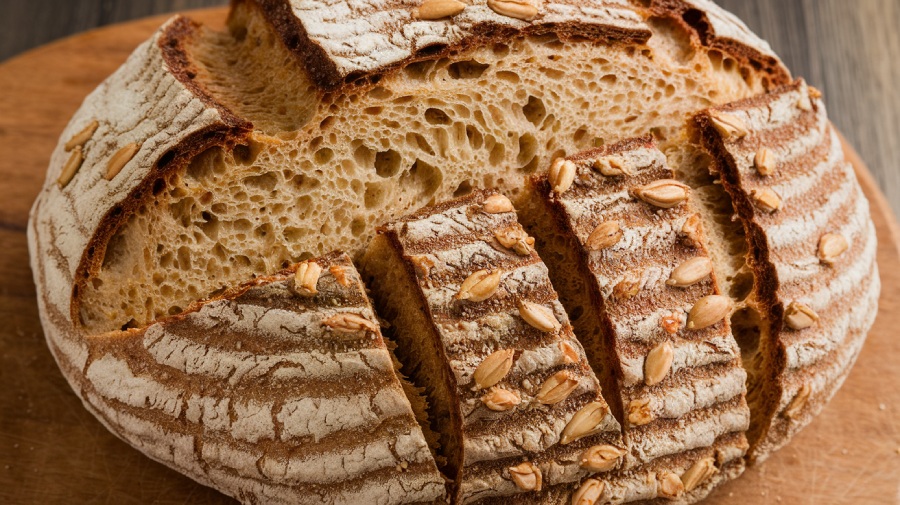
Incorporating a variety of seeds and grains into your sourdough not only elevates the flavor but also boosts its nutritional profile. Regularly feeding your starter while discarding a portion guarantees a healthy balance of yeast and bacteria, leading to better fermentation and flavor development.
By experimenting with different seeds and grains, you can create a unique multigrain sourdough bread recipe that not only tastes great but also offers numerous health benefits to enhance flavor.
Here are some fantastic seed and grain options to take into account:
- Sunflower seeds: Add a nutty crunch.
- Pumpkin seeds: Rich in fiber and protein.
- Flax seeds: Great source of omega-3 fatty acids.
- Hemp seeds: Packed with essential amino acids.
- Sesame seeds: Provide a subtle, earthy flavor.
For your soaker, mix these seeds and a combination of grains like hard red wheat, rolled oats, millet, and rye. Soaking them in hot water allows ideal hydration and flavor development, resulting in a delightful texture.
You can also incorporate whole grain and all-purpose flour for a balanced structure. Don’t hesitate to experiment with varying amounts of quinoa or amaranth to enhance the variety of grains in your loaf.
Flour Types and Ratios
When crafting your multigrain sourdough bread, the right flour types and ratios play an essential role in achieving that perfect texture and flavor. Start with 62.15% organic strong bread flour, which boasts a protein content of 12.4% that helps develop gluten strength. This is vital for supporting the overall structure of your loaf, allowing it to rise beautifully.
Next, incorporate 35.71% whole wheat flour made from stone-milled organic hard red spring wheat for a nutty depth, enhancing the bread’s flavor profile. For a hint of complexity, you can add 2.15% fresh-milled rye flour, although whole rye flour works just as well if that’s what you have on hand.
Your formula should include 10.73% pre-fermented flour, with levain contributing 25% of the final dough. This combination not only enhances flavor but also improves the bread’s texture, making it more enjoyable to eat.
Keep an eye on your hydration level, which should hover around 80.44%, not counting any water from soakers. If you want to tailor your recipe to suit personal tastes or ingredient availability, play around with customizable flour ratios using a dough calculator. This flexibility allows you to create a multigrain sourdough that’s uniquely yours, ensuring each loaf is a delightful adventure in baking!
For additional tips on achieving a flavorful crust, check out baking techniques.
Sweetener Alternatives and Nutrition
While crafting your multigrain sourdough bread, don’t overlook the impact of sweeteners on flavor and nutrition. Choosing the right sweetener can elevate your bread, adding moisture and a richer taste profile.
Here are some fantastic sweetener alternatives to take into account:
- Honey: Naturally sweet, it enhances moisture and flavor.
- Maple Syrup: Offers a distinct taste and works well in the recipe.
- Molasses: Adds depth with a slight bitterness, balancing sweetness.
- Agave Nectar: A lower-glycemic option that’s also sweet.
- Coconut Sugar: A less refined choice with a mild caramel flavor.
Using about 3 tablespoons of your preferred sweetener affects not only the taste but also the nutritional profile of your multigrain sourdough bread. Each slice provides approximately 165 kcal, featuring 31g of carbohydrates, 5g of protein, and 2g of fat.
Sweeteners like honey and molasses can also boost bread’s nutrient content. Molasses is rich in iron and calcium, which contribute to overall health.
Step-by-Step Preparation Guide
To create your multigrain sourdough, start by preparing your ingredients with care, soaking those nutritious seeds and grains to enhance their flavor and texture.
Next, focus on the fermentation techniques that will bring your dough to life, allowing it to develop a robust gluten structure.
Ingredient Preparation Steps
Creating a delicious multigrain sourdough bread begins with careful preparation of your ingredients, setting the stage for a flavorful loaf. Follow these steps to get everything ready:
Start by ensuring your sourdough starter is active and bubbly, as this is essential for proper fermentation and flavor development in the bread.
Soak 1/2 cup of multigrain cereal and 3 tablespoons of seeds in 1 1/2 cups of boiling water for one hour.
In a large bowl, combine 1 cup of active sourdough starter with 1 cup of filtered water, mixing until well integrated.
Add the soaked cereal mixture to the wet ingredients, then gradually incorporate 3 cups of flour (a mix of organic strong bread flour and whole wheat flour works best) and 3 tablespoons of honey or maple syrup until a shaggy dough forms.
Cover the dough with a damp cloth and let it autolyse for one hour; this step enhances gluten development and flavor.
After autolyse, allow the dough to undergo bulk fermentation.
Perform a series of stretch and folds over the next two hours, which will help the dough double in size and develop a bubbly texture.
Dough Fermentation Techniques
Once your dough has completed the autolyse phase and is ready for fermentation, you’ll commence a journey to develop its texture and flavor.
Begin by mixing your soaked grains and seeds with the active sourdough starter, water, and flour. Allow this mixture to rest for 30 minutes, enhancing gluten development, as maintaining an ideal dough temperature can greatly impact fermentation outcomes. During this phase, be mindful of temperature management in fermentation to guarantee active yeast and bacterial behavior.
Next, perform 4-6 sets of stretch and folds over a 2-hour period at room temperature. This technique strengthens the dough, making it wobbly and bubbly, which indicates proper fermentation.
Following this, let your dough undergo bulk fermentation for 8-14 hours at room temperature, or opt for a cold ferment in the refrigerator for up to 36 hours. This cold ferment enhances the flavor and crust development.
Monitor your dough’s readiness by checking for a jiggly texture and confirming it has roughly doubled in size. After shaping, let it undergo a final proof for 5-36 hours in the refrigerator to deepen its flavors.
When you’re ready to bake, place your dough in a preheated Dutch oven for ideal crust formation.
Shaping and Final Steps
As you prepare to shape your multigrain sourdough, it’s vital to make certain your workspace is ready and welcoming. Lightly flour the countertop with rice flour to prevent sticking and create a smooth surface for your dough.
Using a silicone dough scraper, gently ease the dough out of the bowl, taking care to maintain its structure during shaping.
Begin by pulling the edges of the dough into the center, forming a tight ball. Allow it to rest uncovered for 20-30 minutes; this rest period is essential for gluten relaxation.
After resting, flip the dough over and fold the bottom up one-third, sealing the edges firmly. Roll the dough into an oval shape to achieve a uniform loaf.
Next, place the shaped dough seam side up in a floured banneton for final fermentation. This vital step can last anywhere from 5 to 36 hours in the refrigerator, enhancing both flavor and handling.
Baking Instructions
With your shaped dough resting comfortably in the banneton, it’s time to prepare for the baking process that will transform your multigrain sourdough into a crusty, aromatic loaf.
First, preheat the oven to 450°F (232°C) or 500°F (260°C), making certain that your Dutch oven is also heated for ideal conditions.
Here’s what you need to do:
- Score the dough with a sharp blade about 1/2 inch deep and 4 inches long.
- Bake the dough covered for the first 20 minutes to create steam.
- Remove the lid and continue to bake for an additional 30-35 minutes until the crust turns golden brown.
- Monitor the dough’s readiness by checking for a jiggly texture after bulk fermentation.
- Once baked, allow the bread to cool completely on a wire rack.
Storage and Shelf Life
After putting in the effort to create a delicious multigrain sourdough loaf, you’ll want to make sure it stays fresh for as long as possible. For ideal flavor and texture, it’s best to enjoy your sourdough loaves on the day of baking. When stored at room temperature, your bread can last for 3-4 days. To keep the moisture intact, place the cut sides down on a cutting board or plate.
If you need to preserve it longer, your multigrain sourdough bread freezes beautifully. Just pop it in a freezer bag, and it’ll last for up to two weeks. When you’re ready to enjoy it again, you can either leave it to thaw at room temperature or toast it straight from the freezer for immediate use.
Here’s a quick summary of storage options:
| Storage Method | Duration |
|---|---|
| Room Temperature | 3-4 days |
| Freezing | Up to 2 weeks |
Proper storage conditions are essential to prevent staleness and maintain the quality of your bread.
Nutritional Information and Benefits
Multigrain sourdough bread isn’t just a tasty treat; it also packs a nutritional punch that benefits your health. A slice contains around 165 calories, making it a smart choice for meals. With 5g of protein and just 2g of fat, it fits well into a balanced diet.
The bread’s impressive nutritional profile shines through its fiber content, delivering 2g per slice, which aids digestion and helps maintain a healthy gut.
One standout feature of multigrain sourdough is its lower glycemic index compared to standard breads. This quality helps manage blood sugar levels, making it a friendlier option for those monitoring their intake. Enhanced by various seeds and whole grains, each slice provides essential vitamins and minerals, including 18mg of calcium and 1mg of iron.
Frequently Asked Questions
Is Multigrain Sourdough Bread Healthy?
You might wonder if multigrain sourdough bread is healthy.
Imagine sinking your teeth into a slice that not only satisfies your cravings but also nurtures your body. This bread’s packed with fiber, supporting digestion and a healthy gut.
Its fermentation lowers gluten levels, making it easier on sensitive stomachs. Plus, with essential nutrients and a lower glycemic index, it not only stabilizes blood sugar but also contributes to heart health.
Isn’t that a win-win?
Is Sourdough Bread Better for You Than Whole Grain Bread?
You’ll find that sourdough bread often offers more health benefits than traditional whole-grain bread.
Its unique fermentation process enhances nutrient absorption and lowers gluten content, making it easier on your digestive system.
Plus, sourdough typically has a lower glycemic index, helping to stabilize your blood sugar levels.
This delicious bread is richer in fiber and essential nutrients, encouraging healthier eating habits while providing a delightful flavor and texture you’ll enjoy.
Is Sourdough or Multigrain Better for Diabetics?
Did you know that sourdough’s fermentation process can lower its glycemic index by up to 30%?
For diabetics, both sourdough and multigrain options offer benefits, but multigrain sourdough stands out. It combines the advantages of fermentation with higher fiber content from whole grains and seeds, promoting better blood sugar control.
The prebiotics in sourdough enhances gut health, further supporting metabolic balance.
What Is the Best Healthiest Sourdough Bread?
When you’re searching for the healthiest sourdough bread, look for options packed with whole grains and seeds.
These ingredients boost fiber and protein, contributing to better nutrition. Fermentation breaks down gluten, making it easier to digest, even for those with mild sensitivities.
Additionally, the presence of seeds adds essential omega-3 fatty acids and minerals, enhancing the bread’s overall health benefits.
Opt for sourdough that prioritizes these elements for a nutritious choice.
Homemade Multigrain Sourdough: A Tradition Worth Tasting
In the end, baking your own multigrain sourdough bread fills your home with a delightful aroma and connects you to a timeless tradition. It’s like a medieval baker crafting loaves by the glow of a fire.
You’ll find joy in each step, from mixing the grains to shaping the dough. So, roll up your sleeves, embrace the process, and enjoy the delicious rewards of your labor.

